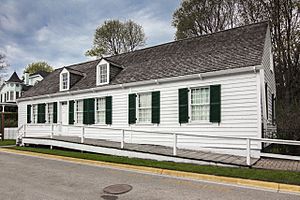Agatha Biddle facts for kids
Quick facts for kids
Agatha Biddle
|
|
|---|---|
| Born | 1797 |
| Died | 1873 Mackinac Island |
| Occupation | Fur trader, community organizer, philanthropist |
Agatha de LaVigne Biddle (1797–1873) was an important woman from Mackinac Island. She had both Odawa and French family roots. However, she mostly connected with her Odawa heritage.
Agatha lived on Mackinac Island during the time of the fur trade. She was a smart businesswoman. She worked closely with her husband, Edward Biddle, in their fur trading business. Her family connections were very important to their success.
Agatha Biddle played a key role in the 1855 Treaty of Detroit. She used her relationships with both Indigenous peoples and settlers. This helped her negotiate on behalf of the Odawa people. She was also known for her kindness and helping her community. She often aided children in need.
The home she shared with Edward, called Biddle House, is still on Mackinac Island today. It was a place where many local gatherings happened. Agatha Biddle was honored by being inducted into the Michigan Women's Hall of Fame in 2018.
Early Life and Family
Agatha was born Agatha de LaVigne. Her mother was Marie Lefevre de La Vigne. Her father was Kougowma, also known as La Vigne, from the Odawa people.
After her father passed away, Agatha's mother married Joseph Bailly. He was a fur trader from Nova Scotia. Joseph Bailly became quite well-known. Agatha and her family lived near Mackinac Island. She stayed close with her mother even after her mother remarried.
Marriage and Family Life
Edward Biddle arrived on Mackinac Island after the War of 1812. Agatha and Edward got married around this time. By marrying Agatha, Edward connected with the important Bailly fur trading family.
Details of their wedding were written down. Many important people from Mackinac society attended. This included Madeline La Framboise. Agatha and her mother wore traditional clothing for Métis women at the wedding. This included layers of cloth, leggings, and moccasins. These clothes were often decorated with ribbons and beads. Agatha continued to wear traditional clothing throughout her life.
It was common for Métis women to marry people from outside their community. However, Edward Biddle was different. He was an English-speaking Protestant American. Most people in the community were Indigenous or French Canadian.
Agatha and Edward Biddle had seven children together. Their names were Sophia, John, Sarah, and Mary, among others. They worked together to build their business. Their youngest daughter, Mary, died at age eight. She fell through the ice while traveling. Her grave is the oldest in the St. Ann cemetery.
Life on Mackinac Island
In the early days of the fur trade, Mackinac Island was mainly home to First Nations people. By the mid-1800s, their numbers were much smaller. This was due to wars, like the War of 1812, and treaties. Many local Odawa and Anishinaabe people had to move to smaller areas of land. Agatha Biddle became a leader for the Mackinac band in the mid-1800s.
Agatha took on many roles in her community. She often took in sick or orphaned Anishinaabe children. She also offered food and other help to those in need. She was known for helping with burials on the island. She provided coffins and helped with funeral services.
Agatha Biddle is a great example of how Métis women used their connections. They had ties to both local First Nations communities and settler communities. This helped them succeed in the fur trade society around the Great Lakes. Evidence shows that Agatha also worked with birch bark. She was skilled in quill work and basketry.


